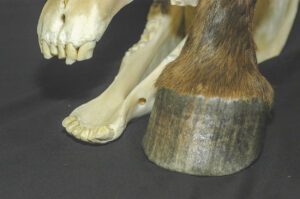Reduce Endocrinopathic Laminitis Likelihood With Nutrition, Medications

Horses with equine metabolic syndrome (EMS) and pituitary pars intermedia dysfunction (PPID) are at a greater risk of developing laminitis than healthy horses. Dietary changes can help reduce that risk and are one of the most important aspects of keeping affected horses healthy.
Those changes are not necessarily cut and dried—they require planning, sourcing of proper feed products, and management shifts. Teresa Burns, DVM, PhD, Dipl. ACVIM, an associate clinical professor of equine internal medicine at the Ohio State University College of Veterinary Medicine, in Columbus, reviewed how veterinarians can use nutrition and medication to help manage endocrinopathic laminitis cases at the 2017 American Association of Equine Practitioners Convention, held Nov. 17-21 in San Antonio, Texas.
“EMS is prevalent in equine populations, and we’re learning more about how to manage it,” she said. “PPID is also very common
Create a free account with TheHorse.com to view this content.
TheHorse.com is home to thousands of free articles about horse health care. In order to access some of our exclusive free content, you must be signed into TheHorse.com.
Start your free account today!
Already have an account?
and continue reading.

Related Articles
Stay on top of the most recent Horse Health news with

















